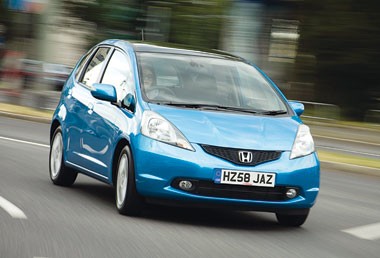Review
Rather like the Mitsubishi Carisma (a car that failed to inject any charisma into the driving or ownership experience), Honda’s Jazz is a similar misnomer.
Jazz implies sparky, sexy and dynamic, whereas the four-wheeled incarnation offers little of these attributes.
Rather, it majors on solidity, dependibility, practicality and affordability.
And why not?
These are the new watchwords and the Jazz does them very well – a car for our times if ever there was one.
The Jazz has put in sterling service for many years among fleets, much of it going unnoticed.
Public sector workers love it, especially district nurses and midwives, because it’s a car that won’t let you down – something which is fairly vital in their line of work.
The new model does everything the old one did, but offers more power, better driveability and more interior space.
It is the latter which is most impressive in the smallest Honda.
The packaging means there is a huge amount of room in the car – the tall body means plenty of headroom, while legroom in the rear would embarrass cars from several sectors above.
The rear seats are also easily folded into the floor at the flick of a switch to create a huge load area.
Boot space is impressive thanks to the twin-tier arrangement which adds extra stowage space under the floor.
With 399 litres of capacity, it is 100 litres bigger than a Ford Fiesta or Seat Ibiza.
The gains in interior space are acheived in part to the way the engine, dashboard and driver are pushed forward in the cabin.
The driving experience majors on comfort, and at this it excels.
The seats and seating position are spot on and the major controls (steering wheel, clutch pedal and gearbox) are all very light to aid ease of use and manouevrability.
As you would expect from a car designed more with urban situations in mind, it’s not as accomplished on longer journeys on faster roads.
With 100bhp the engine is sprightly enough, but get up to motorway speed and the engine note becomes very buzzy.
A sixth gear ratio would calm things down considerably.
Build quality is on a par with the sector leaders – it’s all well put together but some of the plastics used look a little on the cheap side.
The other downside to the interior is the messy nature of the dashboard and centre console – there are simply too many buttons and switches and this becomes confusing for a driver.
But when it comes to space and versatility, the Jazz is a tough act to beat.
Strengths
- Space and versatility
- Strong RV forecast
- Lowest running costs
- Low BIK tax bill
Weaknesses
- Confusing dashboard
- Engine noise at speed
Three rivals to consider
- Ford Fiesta 1.4 Style+
- Mazda 2 1.3 TS2
- Seat Ibiza 1.4 SE
P11D price
Ford’s recent price increase puts the Fiesta at a disadvantage here, costing £200 more than the Honda.
The Seat and Mazda look very good value at the front end, although they offer less power (85 and 75bhp respectively) than the Honda with 100bhp and the 96bhp Ford.
Emissions and tax rates
The Mazda, Honda and Ford all fall into the 15% benefit-in-kind tax band, but the Mazda2’s lower front-end price means the cheapest company car tax bills – £25 a month for a base rate taxpayer.
The remaining three will all cost the same driver £29 a month.
SMR costs
All four run on 15-inch alloy wheels so this spells similar tyre replacement costs. The difference comes down to service intervals.
The Honda leads the way with variable intervals, while the Fiesta and Mazda2 require a garage visit every 12,500 miles.
The Seat has narrow 10,000-mile service intervals.
Fuel cost
With claimed combined fuel economy of 52.3mpg, the Honda and Mazda2 are tied in first place with a likely petrol spend of £4,500 over 60,000 miles.
The Fiesta (49.5mpg) will cost £250 more and the Ibiza (45.6mpg) an extra £660 over the leaders.
Depreciation cost
CAP estimates the Seat will be worth £4,225 (41% of cost new) after three years and 60,000 miles.
The Honda is second – it will be worth more (£5,125/45%) but has a higher front-end price.
The Mazda will be worth £3,725 (37%) and the Fiesta £4,175 (36%).
Wholelife cost
The Jazz comes out on top in two of the three running cost sections and takes a narrow victory over the Mazda2 – the Jazz’s variable servicing intervals making a significant gain over the Mazda’s fixed 12,500-mile intervals.
The Ford and Seat are more than 1ppm adrift.
Verdict
The Seat and Ford are discounted first due to their running cost disadvantage, which leaves the Honda and Mazda2.
While the latter has much to recommend it in terms of style and driving appeal, plus its lower benefit-in-kind tax bill for drivers, it cannot match the overall performance of the Honda.
The Jazz is unsurpassed when it comes to space and versatility, its strong residual value forecast and its running costs proposition.
Used primarily as an urban tool it is also very easy to drive and live with.
Public sector fleets have long championed the Honda and the new model looks set to continue that.
- Winner: Honda Jazz 1.4 ES
















